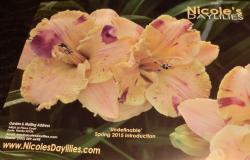chalyse said:As you mentioned in another previous thread, there may be as much as 8% of AHS registered daylilies (whether they are trips or, my question, how many additional may be unreported dip to tet conversions and tets that have reverted to dip) which may not be listed with the correct ploidy, in addition to whatever informal conversions that make it out into circulation (http://garden.org/thread/view_... ).
Researchers have used two different techniques to determine the ploidy of registered daylily cultivars. And there are registered diploids that are not diploid and registered tetraploids that are not tetraploids and some are triploids. Two independent research groups, each using a different method found 6% and 8% of the cultivars they tested had misidentified ploidy. However, there are difficulties in translating those percentages to the actual number of cultivars in our gardens that may have incorrect ploidy.
I think that the 6-8% figure is far too high for what is actually present in most gardens. I have grown more than 600 different named cultivars and I have only found two with incorrect ploidy. One was sold to me as a converted tetraploid and had reverted to diploid - a known and reasonable situation. The other was registered as a tetraploid but is a diploid and is simply some sort of error.
When the researchers chose the cultivars to test they will have tried to make random samples of the daylilies available to them, primarily those that are sold commonly. Most of us do not grow random samples of daylilies. We tend to have special interests and we grow daylilies that meet our interests. The end result is that the cultivars that are sampled by the researchers are not representative of those we grow.
There are also daylily hybridizers who were interested in producing tetraploid conversion of diploids. Originally seed conversion was the method used by many hybridizers. The catch is that when a plant from a seed conversion did not successfully cross with tetraploids it would be assumed that it was an unconverted diploid. If the seedling was good enough to use in crosses as a tetraploid it might well be good enough to introduce as a diploid. However, some of those plants might not have been diploids,
A second known problem during the period when many diploids were being treated to convert them to tetraploids is that some hybridizers identified converted tetraploids by simple physical characteristics, such as the thickness of leaves, sizes of flowers, etc. Those methods are very unreliable so some registered tetraploids were actually diploids. The catch is that if I like a particularly hybridizer's introductions because they fit my tastes and that hybridizer was one whose registrations had ploidy problems then my daylilies may show a higher than typical number of incorrect ploidies. On the other hand, if I specialize in other types of cultivars (for example recently registered cultivars) then the number of plants with misidentified ploidy in my garden may be zero or close to it.
The researchers who found 6% of registered daylilies with incorrect ploidies, had two hybridizers with more than one misidentified cultivar in their tested sample. It is known that the tetraploid registrations of one of those hybridizers were often incorrect. The other hybridizer had tried seed conversions. If those hybridizers are excluded from the sample then the proportion of plants with incorrect ploidies is 1%. As well, all the misidentified ploidies were plants that had been registered between 1981 and 1986. Presumably that is related to a time associated with an intense interest in producing new converted tetraploids.
I place much less confidence in the results of the research group that found 8% incorrect ploidies, primarily since I have a substantial number of the plants they tested and identified as having incorrect ploidies and here they behave as if their registered ploidies are correct. I assume there were some problems with their methods, particularly as in a test of one of the cultivars they identified as incorrect ploidy it was found to have the correct ploidy.
I am also going to introduce an unusual possibility. Diploid plants (any species) produce pollen with problems at high temperatures. The pollen can be dead but also it sometimes can be the incorrect ploidy (due to problems in development associated with the high temperatures). When that happens the pollen from a diploid can be the same ploidy as that from a tetraploid and work on tetraploids - usually at a low percentage. High temperatures do not necessarily affect diploids and tetraploids in the same way since for example the sizes of their cells, etc., are different. High temperatures may possibly cause diploid pollinations to fail more frequently than tetraploid pollinations.
